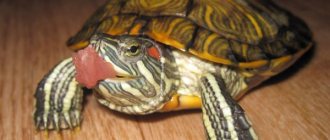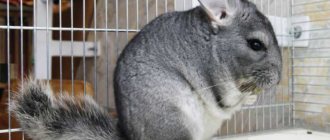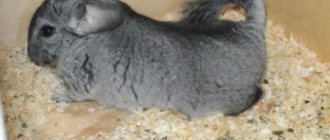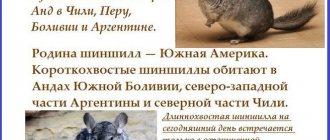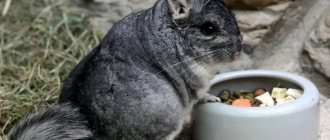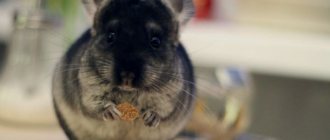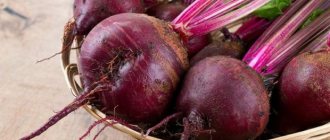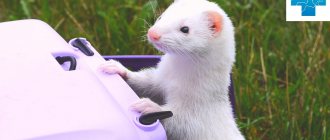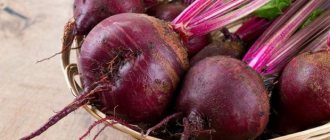Proper feeding at home is one of the main aspects of caring for a Labrador.
The development of the pet and its health depend on this, so it is necessary to approach the preparation of the diet with all responsibility.
Despite the fact that representatives of this breed are omnivores, it is necessary to take into account that there are a number of foods prohibited for them.
Feeding dry food
Choose well-known and proven brands, then you will get all the benefits of “dry” feeding - a balance of nutrients, vitamins and microelements for dogs, a minimum of time costs for you. Add wet canned food of the same brand to dry food. Don't forget about fresh water - there should be plenty of it. In summer, change it several times a day.
Feed comparison
Acana Grass-Fed Lamb
Hypoallergenic, biologically suitable for dogs (holistic), intended for sensitive animals. Contains half and half lamb and vegetables. Does not contain potatoes or grains.
Eukanuba Breed Specific Dry Dog Food Labrador Retriever
Ready food for Labradors. Its basis: poultry (chicken) and cereals. Enriched with calcium. Prevents the formation of tartar.
Advance Labrador Adult
With chicken, grains and dietary supplements for teeth, coat, heart and joints. Designed for adult dogs.
Hill's Nature's Best Canine Adult Large Breed/Giant Dry
The food is optimized for large and giant breeds. Main ingredients: corn, chicken and turkey. Suitable for Labradors as it contains glucosamine and chondroitin for joint health.
Royal Canin Labrador Retriever Adult
Food that takes into account the health problems and needs typical of Labradors: tendency to obesity, stress on joints, water-repellent properties of wool. Contains rice and other grains, poultry.
Natural food or artificial feed
There is no clear answer to the question of which type of feeding is better and healthier for dogs.
The opinions of breeders are similar only in that the diet should be balanced and selected taking into account the dog’s age, its health and activity level.
Labradors are not picky eaters and their menu can be based on both natural products and ready-made industrial feeds, the main thing is not to mix types of feeding, follow the regime and control the portion size.
The ready-made food contains everything necessary for the pet’s health, and the amount of all micro- and macroelements is correctly balanced, which greatly simplifies the owner’s task.
At the same time, natural food is distinguished by its variety and the absence of artificial additives, but it requires the owners to spend time on its preparation.
Expert opinion
Kozhevin Semyon Kirillovich
Expert dog handler.
Unfortunately, many inexperienced dog breeders mistakenly believe that a natural diet involves feeding the dog food from a common table. This is fundamentally wrong and such nutrition has an extremely negative impact on the dog’s health, leading to allergies, constipation and other problems with the digestive system and more. Natural feeding requires knowledge about the composition of the products used and their effect on the animal’s body. Today, there are many industrial foods on the market, developed taking into account the needs of Labradors of different ages, which greatly simplifies the task of owners regarding feeding dogs.
How to change the power plan
Transition your Labrador from one feeding regimen to another gradually, carefully monitoring all the dog’s reactions. The transition from natural food to dry food takes about 7 days, from dry to natural food - 2 weeks, since the pancreas needs time to fully restore its functions.
Do not mix types of food either in a bowl or at time: feed natural in the morning, dry in the evening.
The general translation scheme is as follows:
| Day | Share of natural feed, % |
| 1-7 | 30 |
| 8-10 | 50 |
| 10-14 | 70 |
| from 14 | 100 |
Food selection
The issue of choosing a feeding system has always been and remains controversial. Among dog breeders and owners there are both ardent supporters of natural feeding and adherents of feeding dry food.
NOTE! There are also compromise opinions, for example, the head of the Russian retriever club believes that it is not so important which scheme to choose, but what is important is to do it competently - watch your pet, monitor the condition of its fur, ears, whether there are any signs of allergies
If the coat is shiny, there are no allergies, the dog is in normal condition, is not losing weight, but is not gaining excess weight, then the chosen feeding option is suitable for the puppy.
It goes without saying that when it comes to choosing dry food, the food must be of high quality. If preference is given to natural food, then a competent approach is needed, a careful selection of ingredients and their volume.
Natural diet
When feeding your dog natural food, you must remember: you will have to balance the nutrition in terms of nutrient content yourself, and this is not easy. Please note that it will take a lot of time and effort to prepare. Meat should be at least 50% in the diet, because dogs are carnivores. You should not feed your Labrador retriever food that is too hot or cold, stale, or improperly heat-treated (fried). Preferred Products:
- Lean meat (beef, turkey, chicken, horse meat, rabbit), offal: types that do not cause allergies, boiled, frozen or scalded, cooked offal, raw tripe, unpeeled;
- Sea fish: boneless (hake, cod, pollock), boiled to bind trimethylamine oxide, which causes anemia in animals;
- Dairy products (yogurt, yogurt, bifivit, cottage cheese, low-fat cheese), fresh milk (only for puppies up to 8 weeks old, a little at a time). Add calcium chloride to the milk feed (2 tablespoons per liter before boiling the milk);
- Porridge (rice, buckwheat), flavored with rye breadcrumbs and vegetable oils (linseed, sunflower, olive);
- Eggs (raw (with porridge) only the yolk, boiled or as an omelet - whole);
- Fruits (little by little, except grapes), vegetables (raw grated zucchini, carrots, pumpkin), herbs (dill, parsley, celery).
Sample menu for the week
| Day of the week | Menu |
| Monday | In the morning - cottage cheese with sour cream, fresh vegetables, in the evening - boiled beef, in pieces, with rice boiled in broth; |
| Tuesday | In the morning - an omelet with vegetables and cheese, raw beef, in the evening - chicken breast with buckwheat and herbs or fish; |
| Wednesday | like on Monday; |
| Thursday | like Tuesday; |
| Friday | In the morning - fresh vegetables, chopped, beef meat, raw, cut into pieces, in the evening - chicken fillet with rice; |
| Saturday | In the morning - cottage cheese with bifidok, porridge with vegetables, in the evening - beef with buckwheat and herbs; |
| Sunday | In the morning - porridge with breadcrumbs and herbs, cottage cheese. In the evening - boiled offal (raw tripe) with buckwheat. |
Permitted and prohibited products
A balanced diet for a natural-fed Labrador should consist of::
- low-fat sea fish containing iodine, phosphorus and protein;
- dietary meat - lean beef, chicken, rabbit, turkey;
- boiled offal;
- rice, oatmeal, buckwheat porridge with a few drops of oil;
- fermented milk products fortified with calcium;
- eggs – 1-2 yolks twice a week;
- vegetables - carrots, zucchini, pumpkin;
- fruits, except apples and pears with pits;
- greenery;
- a small amount of salt.
Should be excluded from the menu:
- fatty meat and fish - put a strain on the animal’s liver;
- bones - do not carry nutritional value, provoke constipation, intestinal volvulus, and tubular ones split and, getting into the intestines, injure it;
- beans, pearl barley, semolina and millet porridge, cow's milk - lead to gastrointestinal upset;
- potatoes, cabbage - contribute to bloating;
- smoked meats, sausages - destroy liver cells;
- sweets and chocolate - lead to increased lacrimation, destruction of tooth enamel, disruption of the heart and digestive organs;
- baked goods – lead to obesity;
- onions and garlic – risk of hemolytic anemia;
- sorrel and rhubarb - problems with digestion and urinary system;
- raisins and grapes - the risk of kidney failure.
Also, under no circumstances should you give your Labrador coffee or alcohol..
What to feed a Labrador puppy
Your puppy will be stressed when moving to you. Don’t put him through the trouble of indigestion, find out from the breeder what kind of food he’s used to, and feed him the same thing, at least for the first time.
| Age, months | What to feed |
| up to 1 | breast milk |
| 1-2 | breast milk + complementary foods (dry food soaked in yogurt or kefir (not chicken-based), semi-liquid buckwheat, rice porridge; vegetables (except potatoes), cottage cheese, fish - all in puree form) |
| 3-4 | gradually wean off from “mother”, increase the share of ordinary soft food, replace cottage cheese with meat, poultry and fish cut into small pieces |
| 5-6 | accustom to solid foods rich in protein, vitamins and minerals (meat, sea fish, dairy products, fish oil, powdered eggshells, raw vegetables) |
| 6-10 | regular puppy diet (natural feeding or dry food “for large breed puppies” or “for Labrador Retriever puppies”) |
| 10-12 | transfer to an “adult” diet |
Teach your puppy:
- eat a single serving completely and immediately (keep the bowl of food available for no longer than 15 minutes, give the supplement a little at a time, only for puppies up to six months old),
- do not “beg” the host’s food (do not offer food from your table and forbid children to do this),
- leave the kitchen immediately after finishing the meal.
Look at the discipline these Labrador puppies have!
Menu for the week
| Day of the week | Daily ration |
| Monday | 300 g boiled beef, 200 g rice, 100 g boiled carrots, 150 g cottage cheese, 50 g parsley |
| Tuesday | 300 g chicken meat, 200 g buckwheat, 150 g baked pumpkin, 100 g curdled milk, chicken yolk |
| Wednesday | Boiled fish – 300 g, rice porridge – 250 g, raw zucchini and fermented baked milk – 100 g each and 25 g of greens |
| Thursday | 300 g raw tripe, 200 g buckwheat porridge, 150 g fruits and vegetables, 150 g cottage cheese |
| Friday | 300 g turkey, 200 g buckwheat porridge, 100 g boiled pumpkin and zucchini, 150 g cheese, 25 g lettuce |
| Saturday | 300 g offal, 200 g rice porridge, 200 g carrots and beets, 100 g curdled milk |
| Sunday | 300 g fish, 150 g yogurt, 200 g rice porridge, 100 g omelette, 50 g raw pumpkin |
How to feed a Labrador puppy correctly
Observe the following rules from a very early age of the puppy:
- Feed and water from a high stand (bowls are fixed at the height of the animal’s elbows so that the dog’s posture does not deteriorate).
- Give slightly warmed food (30-37 degrees).
- Provide the puppy with peace afterward, do not take him for a walk to avoid stomach volvulus.
- Do not give food between feedings.
- Introduce new products gradually, starting with small quantities.
- In the first half of the day, feed lightly (dairy products), in the second - give the main part of the food (meat, eggs, vegetables, cereals) and vitamins, since in the afternoon and at night the secretion of gastric juice increases in Labradors.
- Follow a diet appropriate for the puppy's age.
| Puppy age, months | Frequency of feedings, once a day | Single (daily) portion, g |
| 1-2 | 6 | 50 (300) |
| 2-4 | 5 | 60-80 (300-400) |
| 4-6 | 4 | 100 (400) |
| 7-12 | 3 | ~130 (400) |
| from 12 | 2 | 250 (500) ± 70-100 |
Dry food is dosed in accordance with the manufacturer's instructions.
The greatest need for nutrients and biologically active substances occurs in young Labradors at 2-6 months; Pay special attention to your puppy's diet at this age.
From 4 months, feed supplements with calcium, glucosamine and chondroitin for the proper formation of bones and joints, prevention of rickets, hip dysplasia.
You can also watch a short video with an example menu for a Labrador puppy.
Features of feeding during pregnancy and after childbirth
Bitches during pregnancy and lactation are fed fractionally and often - 5-6 times a day. The energy requirement for nursing mothers and bitches is higher. This food regimen for the mother is observed for one and a half to two months after the birth of the puppies. During this period, a special place is occupied by proteins - building materials for the proper formation and growth of babies. If a large litter of puppies is expected, the expectant mother should be fed in small portions. This will prevent excessive stretching of the abdomen.
During lactation, the bitch consumes a large amount of calories. She needs more impressive amounts of food than a dog in her position requires. Food should contain sufficient amounts of protein and fat rich foods. This promotes the production of breast milk and gives the mother energy to feed her babies. With a natural diet, high quality proteins and calcium are sufficient. When feeding a bitch with commercial food, it is worth thinking about additionally introducing fresh, high-protein products into the diet. Suitable raw meat (beef, poultry, lamb, beef by-products: heart and kidneys), goat milk, raw eggs, yoghurt, cheese, cottage cheese, fatty varieties of sea fish (salmon, mackerel).
During the period of bearing offspring, the dog's tastes are often distorted. She may eat foods that she previously refused and ignore foods that she enjoyed eating before conception. At this time, you need to listen to your pet and offer feeding that she likes and matches her instincts.
A pregnant mother will benefit from:
- red viburnum - promotes easier labor, speeds up the process, stimulates milk production;
- kelp and brown seaweed are sources of iron and trace elements;
- fennel - improves digestion, enhances lactation.
What to feed an adult Labrador
A dog’s diet affects its condition, coat condition, activity, and the presence of food allergies (diarrhea, vomiting, rashes, scratching, “running” ears).
Weigh your Labrador and calculate the daily amount he needs:
- meat and meat products - 10-20 g/kg weight (3-4 g/kg protein),
- fat 1-2 g/kg (1/6 of meat),
- carbohydrates - 5-6 g/kg (1/2 of meat).
Divide this amount into two meals: morning and evening. If the dog is inactive, it should be fed once a day.
With dry food it is easier to monitor the dog’s weight, the completeness of the diet, and control the manifestations of allergies than when feeding natural products.
Diet depending on the age of the dog
The main products in a pet's diet vary depending on its age. The older a Labrador gets, the more varied its menu, the more nutritious and difficult to digest the elements.
Detailed article on the topic: “Puppy nutrition: diet planning, daily menu, features and important nuances.”
Food for a puppy at 1 month of age
During this period, complementary foods begin to be added to the nutrition that the female provides to the puppy. The emphasis is on grains and dairy products. It is acceptable to feed the baby with boiled cow's milk, ground low-fat cottage cheese, and viscous ground porridge.
The meat must be boiled and chopped or fed in the form of puree. Its quantity should not be large. Salt and sugar are excluded when cooking.
What to feed next, at 2 months
The diet of a puppy older than 2 months is similar to the diet of the previous period. However, the amount of meat increases and milk decreases. The female practically stops feeding the baby herself. You can add small vegetables, herbs, and vegetable oil to your diet, while monitoring the state of the digestive system after consuming them.
They are also fed a boiled egg 1-2 times a week. Porridge can be made more liquid, but it is also advisable to cook it with milk. Meat and poultry are allowed to be fed in the form of minced meat, not puree.
From 3 months to six months
During this period, puppies significantly reduce the amount of milk in their diet, leaving cottage cheese and kefir. Meat and poultry can be given in small pieces, adding them to porridges and broths. Babies over 3 months old are allowed vegetables, fruits, herbs (parsley, lettuce, dill), and thick soups are prepared for them. Cereal porridges can be made more liquid, and a little salt can be added to all products.
From six months to 1 year
A puppy older than six months begins to grow actively, so the maximum amount of protein and calcium is needed in the diet. In this regard, meat begins to form the basis of the menu; it is given in the form of pieces, minced meat, and porridges, soups, and broths are cooked with it. At this time, it is allowed to feed cooked offal (beef kidneys, liver, etc.).
From 6 months it is allowed to feed sea fish, but you should remove all the bones and boil it. Fermented milk products can be represented by cottage cheese and cheese. If necessary, the pet is given vitamins containing calcium and minerals that support the development of the skeletal system. Eating chicken or quail eggs is also beneficial.
How to properly feed an adult Labrador
An adult Labrador requires energy-rich nutrition, as it is a fairly active breed. The consumption rate is as follows:
- Proteins (meat products) – 15-20 g/kg weight;
- Carbohydrates – 5-6 g/kg body weight;
- Fats – 1-2 g/kg.
It is imperative to monitor the portion size and avoid overfeeding, because dogs are prone to obesity.
The daily intake should be divided into 2 doses ; with low physical activity, 1 feeding . It is imperative to monitor the pet’s condition and behavior and, if necessary, reduce or increase the amount of food, since the needs and absorption of products are always individual.
Food should not be too cold or hot, so as not to damage the gastrointestinal mucosa.
It is advisable to ensure that the bowls are secured at the level of the animal’s elbows, preventing curvature of the back line.
Dry and wet food
Ready-made professional food has a balanced composition that provides all the nutritional needs of the Labrador’s body.
The main requirement for this type of food is high-quality raw materials for production and sufficient energy value.
It is advisable to buy super-premium or holistic food, since they are created using natural ingredients, their composition is high-quality, and all elements are well absorbed. It is important to take into account the breed’s tendency to obesity, not to buy food that is too nutritious and to follow the dosage indicated on the package. Foods that do not contain gluten, eggs, or fish will help you avoid allergies.
The best dry type brands for adult pets are:
- Royal Canin Adult Labrador Retriever is a special option designed to provide complete nutrition for Labrador Retrievers. Ingredients: rice, poultry, fish oil, minerals and so on.
- Acana Grass-Fed Lamb is a brand with a hypoallergenic set of ingredients (rice, lamb, etc.) of high quality.
- Advance Adult Labrador – designed specifically for Labradors. Chicken, grains, vegetables and vitamins form the basis of the food.
- Eukanuba Breed Specific Dry Labrador Retriever is a dry food for Labrador Retrievers that contains rice, poultry, wheat and other healthy ingredients.
- Grandorf Lamb & Rice Maxi Adult – food for large dogs. It features a hypoallergenic composition based on rice and lamb.
- Hill 's Nature 's Best Canine Adult Large Breed a supports the health of large dogs. It is based on poultry and corn and does not contain preservatives.
- Bosch Soft Maxi - food with sweet potato and wild boar, intended for large dogs prone to food allergies.
Wet food can be from Royal Canin, Hill's, Pro Plan and other super-premium brands.
Natural nutrition
The natural type of feeding involves the owner independently preparing dishes for the pet. In this case, food from the table is not suitable; all food must be prepared specifically for the dog, so that the necessary balance of elements is maintained, and there are no substances prohibited for dogs. Achieving harmony is the main task when creating a diet, which is difficult to achieve.
It is believed that the volume of natural food should be about 4% of the animal’s weight. This assumes a daily food intake of 0.7-1.4 kg . Moreover, for males the volume should always be 5-6% greater than for females. They also increase portions in cold weather for all pets, and reduce them in hot weather.
Recommended foods:
- Meat and offal (at least 50% of the diet). It is advisable to use low-fat varieties - beef, lamb, rabbit, turkey, etc.).
- Cereals (rice, buckwheat, millet, oatmeal, etc.). Legumes, semolina, and wheat porridge with caution are not recommended, because they can trigger allergies.
- Dairy products (cottage cheese, plain yogurt, curdled milk, kefir).
- Vegetables.
- Unsweetened fruits.
- Eggs (limited).
- Greenery.
- Sea fish without bones (no more than once a week ).
All products, except vegetables and fruits, must undergo heat treatment. Before preparing food, you need to chop all the elements so that the dog does not choke.
What not to feed
The presence of certain foods in the diet can negatively affect the health of your Labrador. These include:
- Bones. They are difficult to digest and can lead to gastrointestinal upset. Sharp fish and tubular bones can damage the walls of the esophagus and stomach.
- Fried, salted, smoked, spicy. They cause disruption of the gastrointestinal tract, provoke diseases of the liver and gall bladder. Excess salt can lead to heart problems. An increased content of spices has a negative effect on taste buds and sense of smell.
- Sausages. As a rule, these products contain fat and spices that are contraindicated for dogs.
- Onions, garlic, radishes. They have an irritating effect on the stomach and liver.
- Fat. Negatively affects the health of the stomach, liver, and pancreas. This category includes both fat itself and meat with a high fat content (lamb, goose, pork). All elements of the latest product may be contaminated with helminths, which are dangerous for dogs.
- Potatoes, pasta, bread, legumes. Lead to obesity, fermentation in the intestines, allergies, and problems with the pancreas.
- Coffee, alcohol. Have a toxic effect on the body.
- Sugar and confectionery, chocolate. They destroy the tooth surface, have a negative effect on the pancreas, and can provoke the appearance of excess weight.
Even if you exclude foods that are prohibited for consumption, you must pay close attention to the quality and freshness of the permitted food. Spoiled and expired food leads to poisoning and possible death of the animal.
The Labrador's diet has some peculiarities, but does not require significant effort in creating a diet. Regardless of whether you choose to feed natural food or prepared brands of food, you can keep your pet in excellent health. The only condition is maintaining a balance of proteins, fats, carbohydrates, vitamins, as well as the quality of the products.
5 / 5 ( 1 voice )
What to feed an old dog
Age-related changes in the functioning of the Labrador's body are partially compensated by nutrition. It is corrected like this:
- add vitamins to slow down the withering process,
- reduce portions or calorie content of food (by 20%),
- enrich the diet with calcium for teeth and claws,
- add products with glucosamine (beef, hard cheese, cartilage, skin and tendons, salmon) to prevent arthritis,
- follow general nutritional rules, since older dogs often suffer from indigestion.
Is it possible to soak or is it better not to?
As soon as complementary foods are introduced into the dog’s diet, some owners immediately begin to feed “drying”. This cannot be done; the sharp edges of dog biscuits can scratch not only the pet’s delicate gums, but also the mucous membrane of the stomach and intestines after swallowing. In addition, industrial food contains no more than 10% moisture content, which does not satisfy the dog’s needs.
Breeders and veterinarians advise soaking food in liquid: water, vegetable broth or kefir:
- Firstly, this will help avoid pain when changing baby teeth to permanent ones.
- Secondly, this is the easiest way to regulate water consumption.
- Thirdly, this way of eating helps to avoid digestive problems.
You need to soak dry food until all the teeth have changed. However, if your dog has problems with his gums or bite, you should wait. Most dogs are ready to completely switch to drying by the age of seven months.
There are several ways to prepare soaked food:
- Pour water over the granules, but not too cold or hot. The optimal temperature should be approximately 38ºC. After this, let it brew for 15 minutes and mash well with a fork into porridge.
- Hot, but not boiling, vegetable broth is suitable for soaking industrial feed.
- Puppies are given food soaked in breast milk replacer or diluted with dry food.
- In case of dysbacteriosis, you can dilute the “drying” with heated kefir. The main thing is not to overheat the product and serve only after it has completely cooled.
In liquid food, pathogenic microorganisms develop faster, so food should not be prepared in advance. It is best to start preparing half an hour before feeding your pet. If the portion remains uneaten, you should not leave the food until the next feeding.
Feeding pregnant and lactating bitches
Pupping in Labrador bitches lasts about 2 months.
For the first half of the pregnancy, feed the pregnant dog unchanged (excess weight will complicate childbirth).
In the second , they increase the amount of meat (up to 1.5 kilograms per day or ~ 10-15% per week), vitamins and microelements (strictly observing the proportions) or simply switch to food for puppy bitches, the composition of which already takes into account the physiological state and needs animal in building material.
If the dog gets what it needs, then whelping and subsequent lactation will have little or no effect on its condition, coat quality and overall health.
If you switch the bitch to puppy food, there is no need to increase the portions or add vitamins and microelements. Feed your dog 6-8 hours after giving birth unless he asks sooner. With milk, a dog gives away 4-7% of its body weight every day. To ensure that the puppies grow up healthy and do not “drink” it, feed the bitch more often than usual (3-5 times) - the same as in the second half of pregnancy.
Remember about fresh water: it is needed for milk production. If the dog's diet is natural, its food should be liquid (thin porridge, meat soup, milk). Do not give potatoes: starch can clog the milk ducts.
A month to a month and a half after giving birth, gradually reduce the number of times the bitch feeds and the amount of water she drinks in order to smoothly complete the lactation period.
General recommendations for healthy feeding
In order for a Labrador to grow healthy and develop properly, it is necessary to adhere to the basic rules in its diet.:
- food should be warm - cold or hot foods harm the dog’s digestive system;
- Do not mix industrial feed and natural products;
- food must be fresh, products must be of high quality;
- it is necessary to adhere to the feeding regime;
- feeding should occur after walks;
- You cannot give your dog food from the common table;
- you need to give your pet an additional vitamin and mineral complex;
- Clean drinking water should be freely available;
- meat and fish must undergo heat treatment.
The quality of nutrition is reflected in the appearance and behavior of the pet: with the right diet, the dog behaves actively, has a shiny and thick coat and normal weight.
Dull coat, loss of activity and excess weight indicate that mistakes have been made in feeding.
What to feed to avoid allergies
There are many allergy sufferers among the labs. Switch your labrador on dry food to a hypoallergenic line. Consistently exclude milk, chicken, beef, soy and wheat from the natural diet, as the animal can react to any of these products. It takes a long time (a month and a half or more), but as a result you will learn how to feed your special dog.
Follow a hypoallergenic diet; it will be prescribed to your pet by a veterinarian. Using a blood test and intradermal tests, he will determine the type of allergen.
Pros and cons of natural food
Natural nutrition involves the dog consuming only high-quality products, the choice of which is the responsibility of the owner, who checks their freshness before purchasing.
This diet has several other benefits.:
- variety, eliminating the possibility that the pet will get bored with food;
- absence of preservatives, chemical flavors, dyes and flavor enhancers that do not provide any benefit to the animal;
- if an allergic reaction to one of the products develops, you can simply replace it with an analogue without making other adjustments to the menu;
- All nutrients in a Labrador's diet are of natural origin and are better absorbed.
Disadvantages of natural feeding:
- it takes a lot of time to prepare food;
- drawing up a balanced diet is impossible without certain knowledge;
- difficulties with feeding your pet while traveling.
You should also remember that you cannot prepare food for future use, and your pet needs to cook daily.
What food to give to a Labrador with health problems
Obesity
Correct your Labrador's excess weight: reduce the portions by half or switch to food for low-active dogs, which is low in protein and fat, but high in levocarnitine and fiber.
Infectious and oncological pathologies, severe fever
Accompanied by exhaustion of the dog - cachexia. Such animals need a high-energy diet containing a lot of proteins and fats, glutamine, arginine, trace elements, vitamins and fatty acids, but few carbohydrates.
Joint dysplasia
A sick Labrador should receive low-calorie food, with less fat, phosphorus and calcium, and more levocarnitine: weight gain slows down, the load on the bones decreases.
homemade food
By homemade food we never mean food from the human table . At home, you should not give scraps to dogs of any breed, especially such large and active ones. If you decide to feed your Labrador natural food, you will have to create a menu and prepare dog food.
The daily volume is calculated depending on the age, place of residence, condition and activity of the dog. For dogs up to 6 months – 6-8% of body weight; over 6 months – 3-4% of the animal’s weight. For older dogs, 2-2.5% of body weight is enough. The average serving for an adult healthy dog is from 900 to 1400 grams.
The diet is based on fresh meat and meat (fish) products 60%, dairy products and herbal supplements 40%. Fatty meats are not suitable - dogs gain weight very quickly and obesity can develop. It is preferable to focus on the following varieties: rabbit, horse meat, chicken (breast), turkey, veal.
Meat can be taken with veins and cartilage - it is healthier for animals. Keep the tenderloin for yourself. There is no need to cook - just freeze thoroughly in the “deep-freeze” mode and pour over boiling water before serving directly.
What other products should be included when feeding “natural”:
- steamed offal;
- cheese and rye crackers - as a treat and encouragement;
- bifidok, fermented baked milk and yogurt;
- low-fat cottage cheese;
- vegetables – raw, finely chopped;
- raw quail eggs with shell;
- chicken eggs (omelet) 1-2 times a week;
- raw tripe;
- raw beef bone;
- boiled sea fish of low-fat varieties - cleaned of bones;
- complexes of vitamins and minerals.
Read: How to choose vitamins for dogs.
Important! Labradors are prone to obesity, so it is best to avoid cereals, bread and sweet, sugary fruits.
What not to feed
There are foods that dogs of any age and physiological condition should not be fed. Do not give them to your pets under any circumstances.
- Refined sugar: will lead your Labrador to obesity and unbalanced diet. Chocolate is dangerous: the more cocoa it contains (dark varieties), the more caffeine and theobromine, the more likely convulsions, tremors, arrhythmia, and increased thirst are.
- Fat: heavy fatty food will “give” your Labrador problems with the liver and inflammation of the pancreas.
- Salty, smoked, spicy, spices: the first and second will cause severe thirst and, as a result, expansion of the stomach and intestinal volvulus; the third and fourth will ruin the dog’s sense of smell.
- Bones: fish - will get stuck in the throat, cause inflammation, and it will be difficult for the dog to breathe; tubular - sharp fragments will injure the oral cavity, esophagus, stomach and intestines; raw ones are a source of parasites.
- Potatoes, pasta: labs do not digest starch well, and gluten in wheat flour is the cause of allergies.
Golden Retriever Feeding Plans
An adult dog needs to be fed twice a day. Older dogs can be fed once a day. Much depends on whether you and your pet have chosen a natural diet or food.
Dry food
The first thing you need to know is the composition of the feed. All ingredients are listed in descending order and by percentage. Animal proteins should be at the top. It is better to avoid food containing wheat (which most often causes allergies), corn and soy. Ideally, there should be two or more animal proteins. If animal protein is listed first and the next one is printed 8-9 in the list, there is little protein in the feed. Look for food where the first items in the composition are occupied by proteins.
Manufacturer's recommendations for the amount of food do not always correspond to reality: a dog can eat more or less. Divide the recommended amount of food into two or three meals and adjust the dosage to suit your retriever's needs.
A new breed has been developed - Shalaika. A cross between a jackal and a husky.
There are several rules that will protect your retriever when feeding dry food:
- Any food should be stored cold and dry, not allowing it to overheat or get wet. This activates mold growth in it;
- If mold or a bad smell has already appeared, it is strictly forbidden to give it to the retriever. You need to save the package and the date code on it and contact the manufacturer, informing them about this problem;
- If your pet suddenly refuses food that he previously ate with pleasure, you should not feed him either. Their sense of smell is many times better than ours, so they can detect the presence of mold and toxins;
- Under no circumstances should you buy loose food. You don’t know exactly how long it lasts in open bags and whether it was stored correctly in the store;
- It is also prohibited to purchase expired food or those whose shelf life is about to expire;
- Do not feed food with packaging that is damaged or not sealed at the factory;
- Stop giving food if your pet has a negative reaction to it, such as vomiting, diarrhea or nausea, apathy, lethargy, yellowing of the whites of the eyes or skin, allergies, etc. Contact your veterinarian immediately and contact the manufacturers.
Natural food
If you decide to feed your pet natural food, then about half of the diet should be meat. This is chicken, turkey and beef, preferably boiled. This half also includes other protein products, for example, cottage cheese, sea fish (once every seven days, low-fat and boiled). A quarter of a retriever's diet should consist of cereals (rice and buckwheat), and another quarter of vegetables. Among them must be carrots, cabbage, turnips, beets, greens and pumpkin.
It is better not to feed fatty meat, but to remove the skin from the bird. There should be some rough streaks in the meat. You can also give offal a couple of times a week. You definitely need bones, but not tubular ones. Vegetables can be stewed or fed raw, but in grated form.
Feeding puppies and lactating bitches
Lactating and puppy dogs should increase the volume of food by one and a half times. But this is being done gradually. Be sure to increase the amount of calcium in your diet. You also need to add raw egg yolks and vitamin complexes
It is important not to overfeed a pregnant or lactating dog, so as not to provoke obesity, so we monitor the quality of food, not its quantity.
Feeding the puppy after purchase
If you get a small golden retriever, nutrition is the first thing you should take care of. The main thing you need to know is how the breeders fed him. This is how you will have to feed him for another month while the baby adapts to your home. If you want to switch your puppy from natural food to food, or vice versa, you need to do this within three weeks. This is done like this:
- In the first week, we mix a quarter of the new food with three-quarters of the usual;
- In the second - 50/50;
- For the third week we feed 14 pieces of old food and three quarters of new food.
It is better to mix everything directly in a bowl using measuring cups.
Rating of the best food for puppies
Natural lamb (meat delicacy), 1016105
Products from domestic manufacturers are in high demand. Purchased for those who are sensitive to synthetic additives. Preservatives, artificial colors, and additives are not used in production. Contents are gelled. Made from selected components. The cooking technologies are the most modern. There were no complaints about quality. The texture is delicious. No need to dilute with water. You can take it to the country or on the road. You don't need a can opener to open the lid. Serves as food for babies up to one year old. Iron cans are used as packaging.
The price per jar is 93 rubles.
Natural lamb (meat delicacy), 1016105
Advantages:
- monoprotein formula;
- quality ingredients;
- versatility;
- ease of transportation and opening;
- affordable price.
Flaws:
- not installed.
Premium Puppy Large with chicken (1011066)
Country of origin: the Netherlands. Designed for puppies of large dog breeds. Enriched with minerals and vitamins, it helps the baby grow and develop properly. It is in high demand due to its significant meat content. Belongs to the category of universal. Can be given to pets up to one year old. The storage location should be dark and cool. Excessive humidity should be avoided.
The average cost is 400 rubles per 1 kg.
Premium Puppy Large with chicken (1011066)
Advantages:
- the presence of healthy fatty acids Omega-6 and Omega-3;
- strengthens muscles and bones;
- improves the immune system;
- convenient packaging;
- positive reviews;
- makes teeth healthy.
Flaws:
- not found.
Hill's Science Plan (1037163)
Products are manufactured in the Netherlands. The main ingredients are lamb and rice. Provides the baby with a start in life and allows him to unlock his potential. Can be given to babies up to 1 year old, as well as to nursing and pregnant women. The presence of high-quality protein allows you to build muscle mass. Docosahexaenoic acid promotes proper development of vision and brain. Minerals strengthen teeth and bones. Not suitable for adult dogs.
Retailers are asking 719 rubles for a package of 800 grams.
Hill's Science Plan (1037163)
Advantages:
- ease of storage;
- excellent taste characteristics;
- balanced composition;
- quality ingredients.
Flaws:
- none.
Puppy and Junior Large (3 kg)
Dry food. Available in granules. Consists of 49% animal ingredients (beef, pork, chicken). Completely meets the animal's protein needs and increases vital energy. Meat is used fresh for cooking. The finished product remains in its own meat juice, which improves its digestibility and taste characteristics.
The purchase price is 453 rubles per kg.
Puppy and Junior Large (3 kg)
Advantages:
- absence of harmful components;
- saturation with minerals and vitamins;
- base - fresh meat;
- There are no GMOs in the composition.
Flaws:
- not installed.
Puppy all breeds lamb & salmon (1035777)
Universal food suitable for puppies of all breeds. Made from salmon and lamb, with the addition of goji berries, herbs, fresh fish and alfalfa. The formula is rich in vitamins, proteins and fats. The berries keep your pet’s immune system at its best, improve hematopoiesis, vision, and the condition of the dermis. Thanks to parsley, the possibility of cancer developing in a dog is minimal. Alfalfa has a beneficial effect on the digestive tract, improves metabolism, and renews cells. Produced at Czech production facilities.
Purchase price – 453 rubles per kg.
Puppy all breeds lamb & salmon (1035777)
Advantages:
- improves the general condition of the animal;
- promotes its active development;
- saturation with minerals and other useful components;
- normalization of digestion;
- kidney cleansing.
Flaws:
- not identified.
If you refuse to eat: possible reasons
Sometimes dogs refuse to eat. In most cases this is normal, but sometimes it can be a sign of illness. You need to urgently contact a veterinarian if the temperature rises, the animal becomes drowsy and lethargic, diarrhea, vomiting, and bloody discharge appear.
If your dog refuses food, don't force it
Common reasons for refusing to eat:
- binge eating;
- changing your diet or daily routine;
- stress, fear;
- estrus;
- toxicosis of pregnant women;
- other hormonal changes.
When a dog misses its owner during his absence, it loses its appetite. If, while teaching the puppy to solid food, the owner was too impatient and showed aggression towards the pet, he may refuse to eat.
A loving and caring owner knows well what to feed a Labrador. Depending on the pet’s health, a diet is prescribed - either natural food or a dry diet with the addition of wet food. Vitamin and mineral supplements must be mixed with food.
Basic rules for feeding Labradors
Food for a Labrador must contain a large amount of proteins.
The diet for Labradors must be prepared taking into account certain rules. They are as follows:
- This breed needs fractional feeding. As for meals, their quantity directly depends on the age of the dog.
- Do not give your pet food as a snack. This is due to the fact that animals are prone to obesity.
- Food should be fresh and warm; very hot food can injure the mucous membrane. You should also avoid cold food.
- When preparing food for your pet, you should avoid salt or add it in minimal quantities.
- New food products are being introduced into the menu gradually. You need to give them in small amounts and at the same time carefully monitor the dog’s reaction.
Note! Meals should be organized after the walk.
Otherwise, gastrointestinal diseases and bloat may occur. As for the type of food, it all depends on the owner. Few owners are eager to prepare food for their pet separately. Dry food is more convenient in this regard, since there is no need to stand at the stove.
How much and how often to feed
Labrador retrievers need to be fed 2 times a day: morning and evening. When choosing a pet's diet, you need to find out how much a Labrador eats per day. The amount of feed should always be the same. It depends on age, gender, degree of physical activity, climate, characteristics of the dog and even the time of year.
How to train a Labrador at home for beginners
In the harsh northern climate, as well as in cold weather, the dog should eat 15-20% more food than usual. During hot weather, animals are often thirsty, but their appetite decreases, so the amount of food must be reduced and the amount of water, on the contrary, increased.
Important! When choosing a diet for an elderly pet, you need to reduce the amount of carbohydrates by 20%.
The diet of sterilized dogs should be low in calories. Animals that are being prepared for mating require a lot of food. Males eat 10–15% more than females.
Puppies, pregnant, lactating and older dogs especially need a healthy diet
Tips, recommendations, life hacks
Be sure to wash the bowl after each feeding to your dog. Even if it seems clean, pathogenic bacteria quickly multiply in the microscopic residues of food.
Dishes for Labrador retrievers should be heavy and unbreakable. The best option is an enamel bowl or stainless steel container on a stand. You can also use ceramic cookware on a secure stand. The bowl should not have cracks or chips, otherwise the pet may injure its tongue while licking the dishes.
Signs of properly selected food and a balanced diet are the pet’s normal weight and activity, as well as smooth, shiny coat. If the coat becomes dull or the Labrador begins to lose or gain weight, contact your veterinarian to adjust his diet.
During pregnancy, a Labrador's taste may change dramatically - this is normal. It is highly advisable for the expectant mother to add seaweed, various berries, especially viburnum, and fennel to her diet. These vitamin supplements promote healthy digestion, speed up labor and are a valuable source of iodine, iron, copper and other minerals.
Ready-made food for large pets
Good dog food contains all the nutrients necessary for animal health. Very often, dog breeders feed their pets industrially produced dry food, because it takes a lot of time to prepare natural food.
You can offer your pet food of premium and super-premium classes, as well as holistic food. Some manufacturers offer special lines for certain breeds. The Royal Canin brand produces food for Labradors - Labrador Retriever Junior for puppies and Labrador Retriever-30 for adults.
What is important to consider when feeding a puppy
Every owner should know what to feed a Labrador puppy, since the menu for babies is prepared with special care. Pets are growing, so they spend a lot of energy, which needs to be replenished, but since the esophagus is not yet fully formed, the products must be selected wisely.
Complementary feeding is introduced at 1-1.5 months, it usually includes the following products:
- curd mass;
- natural yogurt;
- shredded chicken meat.
It is allowed to give granulated food for puppies; the complex contains phosphorus and calcium necessary for growth and development. But the pads should first be filled with water and given soaked.
Diet: frequency of feedings and volume of portions by month
The diet is tailored to the puppy's age. You can use the following scheme:
- in 1 month you can give low-fat kefir and meat puree, the number of feedings is up to 6 times, the total daily dose is 300 g;
- from 2 months - cottage cheese, minced meat, porridge, 5 meals of 60-80 grams per serving;
- 4-6 months - the frequency of feeding is reduced to 4 times a day, the dose is increased to 100 g, you can give boiled vegetables, small pieces of meat, add offal;
- at 6 months, all permitted foods are included in the diet, and the dog is gradually transferred to two meals a day.
Important! Your pet should always have fresh water readily available, but the bowl with uneaten food should be removed.
Complementary feeding is introduced to puppies after they are one month old.
Dietary errors: excess weight
Vigor, activity, thick and shiny coat, ideal skin condition and normal weight - all this can be considered signs that you are feeding your pet correctly with natural foods. Unfortunately, not all owners manage to properly prepare a Labrador’s diet, which leads to a wide variety of health problems for the dog.
Obesity is the most common problem among Labradors. If your dog's weight begins to fall outside the normal range, reconsider the daily feeding schedule and the calorie content of his diet. It is also recommended to increase the duration of active walks, which will help normalize the pet’s weight.
Other signs of an eating disorder include:
- redness of the mucous membranes of the eyes and ears;
- diarrhea or constipation;
- rumbling in the stomach;
- severe hair loss.
If the owner of a Labrador retriever has questions regarding feeding the dog “natural” food, you should consult a veterinarian.
Description of the breed
The Labrador breed was officially registered in the 19th century in Britain, where it was brought from Canada. The original name was St. John's. Later, a new name took root - Labrador, or Lab for short. Full name: Labrador Retriever. A dog of large size and extraordinary intelligence. Takes 7th place among dogs in terms of intelligence out of 80 applicants. Can be trained perfectly. The original color is black. Later, the chocolate and fawn generations appeared.
The height of an adult at the withers is no more than 57 centimeters. Dogs are distinguished by powerful paws, drooping ears, and a large head. The body is straight, the loin is wide. The well-set, strong neck and “deep” chest are impressive. The front legs are straight, the hind legs are well developed. The tail is short and thick. The eyes are medium in size, hazel or brown in color. The ears are close to the head.
The character is loving, the mood is always good. They show playfulness and calmness towards people; they will never offend or scare people. Training them is a pleasure. They not only quickly learn commands, but also honestly try not to let their owner down. They get along easily with people and animals. Only birds are not liked, as they are considered hunters.
A real family member, with his own mood and habits. Participates in all important events. Needs communication, but never gets boring with his presence. Carefully observes the mood of those present and does not bother them. A dog can easily be taught to open and close doors, turn lights on and off, and fetch things and slippers. Children dote on them, and the dogs reciprocate. You couldn't find a better nurse and friend for kids.
You need to train your animal regularly. Experts recommend not resorting to punishment for disobedience. The dog will not hold a grudge, but his mood will worsen. Good behavior should be praised, gentle words spoken, and goodies given. If your pet has done something wrong, it is enough to strictly say the word “no”. Intonation will tell your pet that something needs to be changed in their behavior.
The pet does not need special care. It is enough to comb the coat once a week, brush the teeth daily and make sure that parasites do not appear in the ears and dirt does not accumulate. You shouldn't bathe every day. Nails are trimmed once every 10–12 days.
A review of reviews shows that the dog has many more positive characteristics than negative ones, but the latter are worth paying special attention to:
- excessive kindness does not allow the Labrador to become an excellent guard;
- the desire to chew something is constantly present;
- lover of water, even dirty rainwater;
- loves to “bask” in garbage, brings dead mice and birds to the owner;
- snores loudly;
- cannot stand loneliness;
- requires a lot of free space (he is cramped in the apartment).
